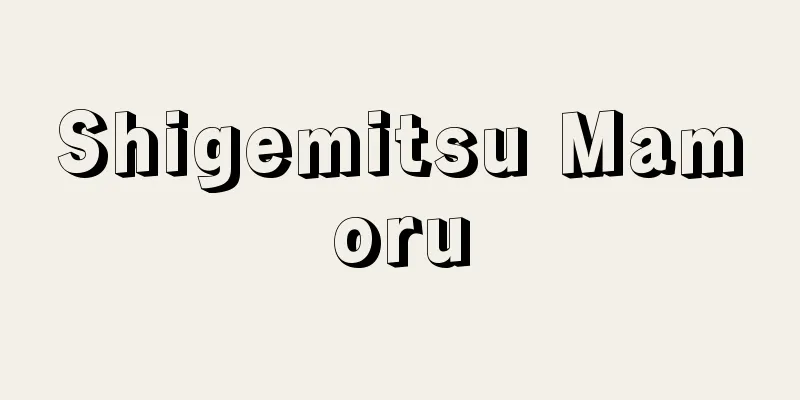Shigemitsu Mamoru

|
Diplomat and politician. Born in Oita Prefecture. After graduating from the Faculty of Law at Tokyo Imperial University in 1911 (Meiji 44), he joined the Ministry of Foreign Affairs. He served as an attendant to the Plenipotentiary at the Paris Peace Conference and as Consul General in Shanghai. In 1932 (Showa 7), while negotiating the Shanghai Armistice Agreement as an envoy to China, he lost his right leg when an anti-Japanese activist threw a bullet at the Tencho Day celebration venue. In 1933, he became Vice Minister of Foreign Affairs and served as ambassador to the Soviet Union, Great Britain, and China. In 1943, as Foreign Minister in the Tojo Hideki cabinet, and in 1944, as Foreign Minister and Minister of Greater East Asia in the Koiso Kuniaki cabinet, he played an important role in wartime diplomacy, such as hosting the Greater East Asia Conference and working for peace through the Soviet Union. After Japan's defeat, he signed the surrender document as Foreign Minister in the Higashikuni Naruhiko cabinet, but was arrested as a Class A war criminal at the request of the Soviet Union at the International Military Tribunal for the Far East. In 1948 (Showa 23), he was sentenced to seven years in prison, released on parole in 1950, and after his expulsion was lifted in 1952, he returned to politics and became president of the Kaishinto Party. He later served as vice president of the Japan Democratic Party and the Liberal Democratic Party. From 1954 onwards, as Minister of Foreign Affairs in the Cabinet of Ichiro Hatoyama, he worked hard to achieve Japan's accession to the United Nations and the restoration of diplomatic relations between Japan and the Soviet Union. His books include "Showa Turmoil," "Sugamo Diary," and "Diplomatic Memoirs." [Yuji Odabe] "Collection of Shigemitsu Mamoru's Diplomatic Opinions," compiled by the Shigemitsu Mamoru Memorial Museum and supervised by Takeda Tomoki, 3 volumes (2007-2010, Gendai Shiryo Publishing) [References] | | |Source: Shogakukan Encyclopedia Nipponica About Encyclopedia Nipponica Information | Legend |
|
外交官、政治家。大分県生まれ。1911年(明治44)東京帝国大学法学部卒業後、外務省に入る。パリ講和会議全権委員随員、上海(シャンハイ)総領事などを歴任。1932年(昭和7)中国公使として上海停戦協定交渉中、天長節祝賀式場における反日運動家の投弾により右脚を失った。1933年外務次官となり、ソ連、イギリス、中国の各大使を務める。1943年東条英機(とうじょうひでき)内閣外相、1944年小磯国昭(こいそくにあき)内閣外相兼大東亜相として大東亜会議の開催やソ連を通じての和平工作を図るなど、戦時外交に重要な役割を果たした。敗戦後、東久邇稔彦(ひがしくになるひこ)内閣外相として降伏文書に調印したが、ソ連の要請により極東国際軍事裁判のA級戦犯として逮捕される。1948年(昭和23)禁錮7年の判決を受け、1950年仮釈放となり、1952年追放解除後、政界に復帰し改進党総裁となる。その後、日本民主党、自由民主党副総裁を務める。1954年以降は鳩山一郎(はとやまいちろう)内閣外相として、国連加盟、日ソ国交回復に尽力した。著書に『昭和の動乱』『巣鴨(すがも)日記』『外交回想録』などがある。 [小田部雄次] 『重光葵記念館編・武田知己監修『重光葵外交意見書集』全3巻(2007~2010・現代史料出版)』 [参照項目] | | |出典 小学館 日本大百科全書(ニッポニカ)日本大百科全書(ニッポニカ)について 情報 | 凡例 |
Recommend
Protomyces lactucae (English name)
…[Tsubaki Keisuke]. . . *Some of the terminology ...
Henotikon
…The Persian army invaded the eastern border, and...
Alpenhorn - Alpenhorn (English spelling) German
A lip-reed aerophone used by shepherds in the Alp...
Cheiron (English spelling)
...Later, when the hero Hercules passed through t...
Meniere's disease
What kind of disease is it? Main symptoms and prog...
Bambi - Bambi (English spelling) Bambi. A life of adventure in the Walde
An animal tale written by Austrian author Salten....
Kenaisetsu - Kenaisetsu
This is the core idea of Mohist thought, preache...
Donut phenomenon - Donut phenomenon
Rising land prices and worsening living conditions...
Case law - Case law
A judgment that has generality as a precedent. In...
English Women's Domestic Magazine
…Magazines advocating women's rights, such as...
Hirosato Chosho
A senior retainer of the Satsuma domain in the la...
chenille yarn
…Narrow woven fabrics with raw silk in the warp a...
Yajnasri Satakarni (English spelling)
…His son, King Bāsishtiputra (also called Śrī Pur...
pâte sucrée (English spelling) pate sucrée
… There is also an instant folded pie dough, whic...
Takashina Takako
Year of death: 2.10 (996) Year of birth: Unknown. ...







![Fujioka [city] - Fujioka](/upload/images/67ccb239a0cdc.webp)

